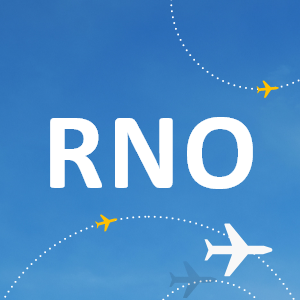
Reno-Tahoe International Airport (RNO) is the principal commercial airport in northwestern Nevada, serving a total catchment area of 1.5 million people. From 2008 through 2014, total passenger traffic at RNO dropped by 1.2 million (25.5 percent). However, traffic nearly completely recovered between 2015 and 2019, rising by 1.1 million. The rebound in commercial air service has accompanied a similar rebound in the regional economy, which sought a return to its traditional tourism-driven sectors while diversifying into new and emerging industries. The Reno-Tahoe region is included as a case study based on the recovery of its economy and air services following the Great Recession (2007–2009).

Introduction to the Region and Its Economy
| 2008 | 2015 | 2019 | Change 2008-2015 | Change 2015-2019 | |||
|---|---|---|---|---|---|---|---|
| # | % | # | % | ||||
| Population (000s) | 574 | 600 | 638 | 26 | 5% | 38 | 6% |
| Total Employment (000s) | 369 | 362 | 414 | (7) | -2% | 52 | 14% |
| Source: U.S. Bureau of Economic Analysis (BEA) | |||||||
The Reno-Tahoe-Fernley Combined Statistical Area (“Reno-Tahoe region” or the CSA) encompasses the northwestern corner of the state of Nevada including the state capital of Carson City as well as the state’s second most populous city, Reno. The CSA had a 2019 population of 638,000.
The region experienced a significant loss of employment associated with the Great Recession. From 2008 through 2015, total employment in the area dropped by 6,700 jobs even though the population grew by approximately 27,000 persons. Since then, as the national economy and regional economies recovered, the CSA added more than 50,000 new jobs, growing to well above pre-recession levels.
Regional Economic Strengths
Traditionally, the area’s employment base has been grounded in government service and tourism-related sectors. Public service, which includes public education (e.g., Nevada State University, Reno) as well as government activity associated with the state capital and multiple major municipalities, is the largest employment category in the region. Additionally, the area’s gaming industry and proximity to Lake Tahoe and resorts in the Sierra Nevada have long made it a major tourism destination.
Since the Great Recession, which negatively affected tourism sectors, the region has had a major recovery in economic activity that is due in large part to emerging business activity in advanced manufacturing, high-tech, biotech, and logistics. New infrastructure, such as the Tahoe-Reno Industrial Center, has supported the arrival of large employers in distribution/warehousing, data centers, and manufacturing—sectors that drove net new job growth and increased average incomes between 2015 and 2019.
Overview of the Airport and Its Services
RNO is Nevada’s second largest commercial airport by passenger traffic, serving more than 4.3 million passengers in 2019. The past decade of passenger traffic at RNO is marked by two distinct periods. The first, between 2008 and 2014, marked the continuation of a decade-long decline in traffic. During the second period, from 2015 to 2019, RNO experienced a period of strong growth, rising from 3.2 million passengers to more than 4.3 million passengers (a compound annual growth rate of 6.0). This rebound came as the region experienced a resurgence in economic activity, as well as a re-introduction of seat capacity by multiple airlines.
Southwest is the primary passenger carrier at RNO, although several other airlines offer a diversity of low-cost, ultra-low-cost, and mainline services.
Connectivity
“Connectivity” generally means the ability to reach a wide range of places in a short amount of time. Changes in connectivity can have notable impacts on how easily northwestern Nevada can be reached or how local residents and businesses can access outside markets.
By 2019, although seat capacity remained 13 percent lower than seat capacity in 2008, RNO’s connectivity nearly returned to prior levels. RNO retained and, in some cases, increased seat capacity to major hubs such as Los Angeles International Airport (LAX), Denver International Airport (DEN), San Francisco International Airport (SFO), Seattle–Tacoma International Airport (SEA), Phoenix Sky Harbor International Airport (PHX), and Dallas Fort Worth International Airport (DFW). RNO has become better linked into hubs, thereby maintaining its overall connectivity.
Air Service and Economic Activity

RNO’s origin and destination (O&D) traffic is positively correlated with total regional employment. As total regional employment increases, O&D traffic generally increases too. It is important to note that correlation does not establish causation. That is, it is not evident whether rising total employment levels lead to more air traffic or whether more air traffic leads to more total employment. Nonetheless, growth in O&D traffic at RNO is more highly correlated to regional employment than regional population, suggesting that employment (and by extension economic activity) is more closely related to aviation traffic growth than population growth alone.
Stakeholder Perspectives on Contribution of Air Service to Economic Development
The airport authority’s strategic priorities involve a commitment to working with regional stakeholders, including partnering with local economic development and business associations to understand market demand. Air service development (ASD) at RNO is also supported through the Regional Air Service Corporation (RASC), a consortium of public and private entities that collects community input on ASD initiatives including much of the private financing for ASD marketing. Representation at RASC has diversified over time to include businesses beyond the region’s traditional gaming sector.
Community stakeholders acknowledge that air service supports all the region’s economic development goals in some way, although most notably as a direct driver for community development. The provision of balanced air service options (from ultra-low-cost carriers to large network carriers) and connectivity to nearly anywhere within the United States in one stop or less attracts not only “big business” into the region but also supports small businesses and the community at large.
